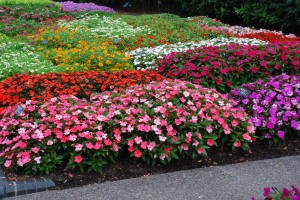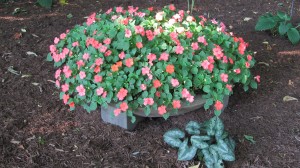Downy mildew in impatiens (Plasmopara obducens) infects garden impatiens, double impatiens and balsam. However, New Guinea impatiens, SunPatiens™, and most annual summer flowering plants are not susceptible. Impatiens are the favorite flowering annual used in shady garden areas. Double impatiens and balsam are favorites in hanging pots and other types of containers.
U.S. greenhouse growers continue to be vigilant when outbreaks of downy mildew are spotted. All diseased plants are disposed immediately and not sold to consumers. Mistakenly, healthy looking impatiens may be shipped that have been contaminated with the microscopic “oospores” which cause the disease. The plants do not show visible symptoms at time of shipping. Contamination of the garden soil with the long-lived downy mildew oospores may become a serious problem in the years ahead.
Early symptoms of diseased impatiens may appear as yellowed or off-colored leaves with a white mildew coating the foliage underside. Eventually, most leaves turn yellow and fall off, leaving only the stems.
Infected plants in the garden can not be saved by spraying a fungicide. Greenhouse growers and professional landscapers have downy mildew fungicides available to them, but these products are not available to home gardeners. Your best planting alternatives in shady garden areas are New Guinea impatiens, SunPatiens, shade coleus, and torenias.
A remedy for impatiens downy mildew disease will be found. Right now, do your part by not spreading this problem.
• Special thanks to Dr. Alan Windham, Extension Plant pathologist, University of Tennessee Plant and Soil Diagnostic Lab, Nashville, TN.



 Posted in
Posted in 
